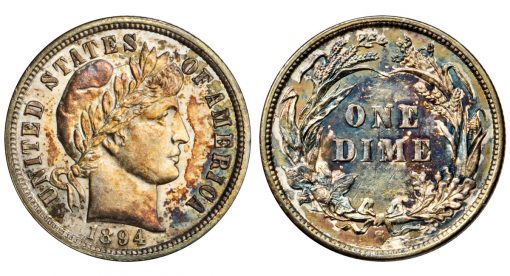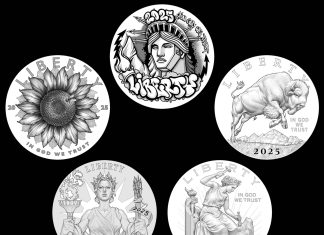Of all great American coin rarities, the 1894-S dime stands high in the front rank. The appearance of one in the marketplace is always a cause for excitement. Over a long period of years Stack’s Bowers Galleries has offered several, always to excitement and acclaim.

Now comes another — a coin that has been off the market for more than three decades and is fresh to most of the present generation of bidders.
This coin is an old friend, so to speak, as Stack’s sold it in January 1953 as a highlight in the F.S. Guggenheimer Collection, after which it passed through other hands to Los Angeles sports magnate Jerry Buss.
It was last sold 31 years ago. Now at the forthcoming ANA World’s Fair of Money in August it will cross the block again as part of the E. Horatio Morgan Collection, a private cabinet with many treasures.
It has been graded Proof-63 by PCGS, a branch Mint Proof. Of the 24 coins minted (of which 19 were distributed), only nine can be traced today.
Although Stack’s Bowers Galleries has handled more than its share of rarities, it has been 12 years since they last offered an 1894-S dime. All eyes will be on the Rarities Night Session, Thursday, August 15, 2019 when this prize is presented for auction.
History of the 1894-S Dime
The fame of the 1894-S dime is well earned, as it has been studied and publicized in numerous books and publications over the years, beginning with an article in the August 25, 1895 San Francisco Call and continuing to the present day. In fact, this issue is so popular that it was ranked number six in 100 Greatest U.S. Coins by Jeff Garrett and Ron Guth.
Although 10 pairs of dies for coining dimes were sent from Philadelphia to the San Francisco Mint, the only production was a run of 24 coins on June 9, 1894, using just one die pair. Coins struck from these were prooflike in appearance, but were not mirror Proofs in the style that would have been made for the numismatic trade. Nevertheless, in later years collectors and dealers often described them as such.
Various theories as to why only 24 were made have been printed, but none have been supported by facts. It is said that Mint employees received some, and that others were placed into circulation at face value.
Of the 24 1894-S dimes struck, five were submitted for assay.
On June 9th, the day of the coinage, two coins were sent to the director of the Mint in Washington to be assayed, which was done soon afterward. On June 25th two dimes are listed as part of the coins assayed by the San Francisco Mint during the month of June 1894. Another specimen was sent on June 28th to the superintendent of the Philadelphia Mint to be reserved for the annual Assay Commission to review coinage of 1894 early in the next year.
No other orders for coinage were forthcoming, so the mintage for that year remained at just two dozen coins and the net distribution was just 19 coins.
The Annual Report of the Director of the Mint, dated November 24, 1894, covered the fiscal year that began on July 1, 1893, and ended on June 30, 1894. The production of dimes for that period was 1,491,425 pieces totally. The Annual Report of the Director of the Mint for the next year, 1895, gave calendar year figures for 1894, including the production of just 24 dimes.
As for collectors, in 1894 there were relatively few numismatists who collected coins from the branch mints. Although Augustus G. Heaton’s Mint Marks, published the year before, enjoyed wide sales, the concept did not really catch on until years later.
Among the exceptions was John M. Clapp, a Pennsylvania oil man and Washington, DC financier, who in 1893 began ordering coins directly from each mint. On November 2, 1894, he wrote to San Francisco to order one example of each coin. Acting Superintendent Robert Barnett replied on the 9th, stating that "We have no coinage dimes 1894."
During the year several others wrote or sent orders for 1894-S dimes and received the same response. This would seem to indicate that by autumn there were no 1894-S dimes on hand at the mint. If some employees had examples, this was not mentioned. It also gave no indication that coinage was expected.
By the turn of the 20th century, the 1894-S dime had been noted by Heaton in his update to Mint Marks in the March 1900 issue of The Numismatist, and a few collectors were known to have acquired examples, including John M. Clapp who had two. The fame of the dime only grew through mention in print and the publicity that accompanied the offering of specimens at major auctions.
Over the years estimates of the number of 1894-S dimes extant have varied, but as of 2019 there are nine confirmed specimens known.
The 1894-S dime from the E. Horatio Morgan Collection will be presented in the Rarities Night Session of the Stack’s Bowers Galleries Official Auction at the ANA World’s Fair of Money, Thursday, August 15, 2019 at the Donald E. Stephens Convention Center in Rosemont, Illinois. For more information contact Stack’s Bowers Galleries at 800-458-4646 or visit StacksBowers.com.
Stack’s Bowers Galleries conducts live, Internet and specialized auctions of rare U.S. and world coins and currency and ancient coins, as well as direct sales through retail and wholesale channels. The company’s 80-year legacy includes the cataloging and sale of many of the most valuable United States coin and currency collections to ever cross an auction block.





